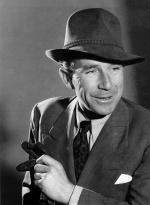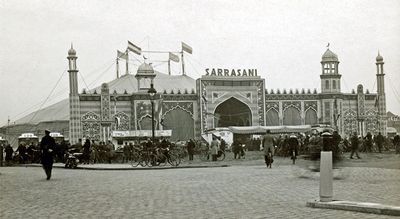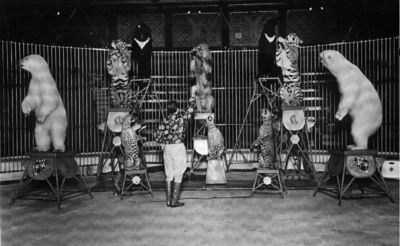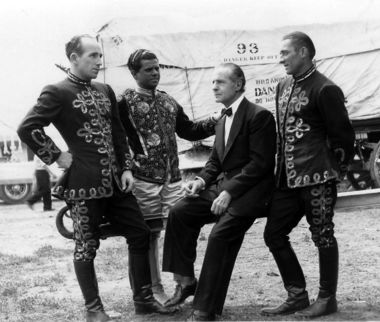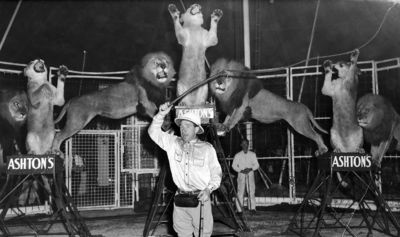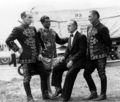Fritz Schulz
From Circopedia
Animal Trainer
By Dominique Jando
The German wild animal trainer Fritz W. Schulz (1910-2010) was one of Australia's most celebrated circus personalities. He had a long and brilliant career that spanned six decades on three continents; upon his death in 2010, he was the last surviving member of a group of exceptional cat trainers who had worked for the legendary Alfred Court. Court had described Schulz as a “honest and courageous guy, who had what it takes to become a great trainer.”
Fritz W. Schulz was born on December 10, 1910 in Krampe, a small village near the town of Grünberg in Silesia (today Zielona Góra, in Poland). His father, Wilhelm, was a weaver; his mother, Maria (née Weinart) had died when Fritz was six years old. Following in the footsteps of his uncle, Christoph Schulz, who had become a famous wild animal trapper for the firm of Carl Hagenbeck, Fritz apprenticed as a butcher. But he shared with his uncle a passion for wild animals—and not particularly dead ones!
Circus Debut
In 1929, Fritz Schulz visited the giant Circus Sarrasani in Nuremberg, and caught the circus bug. He decided to take a job as a groom, and became one of the many employees who tended daily to Sarrasani’s stable of 250 horses. As legend has it, Fritz first came into contact with wild cats when he helped re-capture a tiger that had escaped from the circus’s menagerie. The original trainer was fired, and replaced by the tiger trainer Gustav Ohrt, who needed a cage boy able to cut the raw meat for his cats’ daily meals. Fritz took the job on the condition that he could also work with Ohrt as a cage assistant during his training sessions. Thus Fritz Schulz began his apprenticeship as a cat trainer(English/American) An trainer or presenter of wild cats such as tigers, lions, leopards, etc..In 1932, Fritz accepted a similar job with Sarrasani’s main competitor, the three-ring Circus Krone—but there, he had to prepare 2,000 pounds of meat daily for the thirty tigers of Fernand Montbaron and Alfred Bendix, and Togare’s eight lions. Bendix and Togare were master trainers, but Fritz had too little spare time left to learn efficiently from them, and he decided to return to Sarrasani.
Circus Sarrasani had been severely hurt by the economic depression—which was particularly disastrous in Germany—and it had had to lay off some of its star animal trainers. This situation was a godsend for the young Fritz Schulz, who was given the opportunity to take over a group of tigers that had been previously presented by Hermann Haupt. After a few animated rehearsals under the expert guidance of Franz Kraml (during which he learned to know his charges a little too intimately at times), Fritz Schulz made his professional debut as a full-fledged cat trainer(English/American) An trainer or presenter of wild cats such as tigers, lions, leopards, etc. in 1933 at Circus Sarrasani, in the Saxon city of Chemnitz.
Then, in need of cash, and not eager to remain in Nazi-controlled Germany, Sarrasani embarked in 1934 on one of his lucrative South-American tours, with Schulz in tow. During his stay in South America, Fritz eventually increased the number of tigers he presented to twelve. Sadly, however, Hans Stosch-Sarrasani—known as "The Maharajah," and one of the greatest circus directors of all times—passed away in September of the same year, while the circus was performing in Buenos-Aires.
Under the new management of Hans Stosch, Jr., who, unlike his father, was a member of the NSDAP (the Nazi party), Circus Sarrasani, its coffers flush with good foreign currency and having secured some support from Propaganda Minister Joseph Goebbels, returned to Europe in 1935—in time for the 1936 Summer Olympics in Berlin. Schulz was sent to work with Sarrasani’s tigers at Circus Orlando, in Norway.
Trainer For Alfred Court
Then Hermann Haupt returned to Sarrasani and reclaimed his tigers. In February 1936, Schulz found work as assistant to Alfred Court, on the recommendation of Court’s first assistant trainer, Max Stolle. Court, who had definitely folded his Zoo Circus tents, was then beginning his new performing career as a star cat trainer(English/American) An trainer or presenter of wild cats such as tigers, lions, leopards, etc. at Cirque Medrano in Paris, with La Paix dans la Jungle, a mixed animal group composed of three lions, two tigers, two leopards, three polar bears, and three black bears.
For the spring/summer season of 1937, Alfred Court signed with Blackpool’s Tower Circus in England, with a larger group of ten lions, four tigers, two leopards, four polar bears and two black bears. Court presented the act during the evening shows, leaving Fritz Schulz perform during matinees (under the name of François Scholz, which sounded more French). On the opening matinee, May 17, 1937, Fritz had the thrill of experiencing his first standing ovation.Further engagements with Court followed during the winter, at Berlin’s Wintergarten, the Apollo Theater in Dusseldorf, and the Agricultural Hall in Islington, near London, for the Holiday season. Then, the act was featured for the 1938 season at Circus Knie in Switzerland. During the winter break, it was remodeled and Fritz was sent to work with the new mixed animal group to Cirkus Scott in Sweden.
When World War II started in Europe in September 1939, Alfred Court was finishing the season at the Tower Circus in Blackpool, England. His three other acts were performing in Scandinavia: Schulz’s mixed group, another mixed group presented by Harry Kovar, and a tiger act. Court managed to gather his troupes and bring the rest of his menagerie and his employees to England. Schulz spent the winter season at Belle Vue Circus in Manchester. Court’s round-up was motivated by the fact that he had received a timely offer from John Ringling North to go to the United States and work with all his animals on The Greatest Show On Earth.
The American Years
So, in the beginning of 1940, Alfred Court embarked eighty animals, twenty employees (among whom Fritz Schulz, Joseph Walsh, Harry and May Kovar, Damoo Dhotre, Otto Suskov, and Court’s nephew, William Storey), and all his equipment in Liverpool aboard the West-Chatala, which set sail for the New World.
Ringling Bros. and Barnum & Bailey’s new show debuted at New York's Madison Square Garden on April 4, 1940. Court opened the show with a triple cage display: May and Harry Kovar with a group of lions, tigers, leopards, dogs, polar and black bears in ring one; in the center ring, Alfred Court himself and Damoo Dhotre presented a group of snow leopards, black jaguars, black panthers, leopards and cougars, followed by a group of tigers, lions, leopards, polar and Himalayan bears, and a couple of great Danes; and in Ring three, Fritz Schulz, under the pseudonym of Frederic Olsen, which sounded less Germanic to the management’s ears, worked with a group of male lions.The following year, the three displays were all mixed animal acts, Fritz presenting his group with Joseph Walsh. But The United States had entered the war in December 1941, and German citizens in the United States began to be rounded up and sent to internment camps. Fritz applied for a U.S. citizenship, but was denied and eventually, in 1943, sent to Fort Meat, a camp near Baltimore, Maryland, where he was detained until 1945.
After his release, Fritz Schulz remained for a while in the United States, and trained service dogs for the blind, and then a group of horses. On May 26, 1946, he married Sonya Poll, a dancer he had met when she was a member of the Escamillo Ballet at the Circus Sarrasani building in Dresden. On his marriage certificate, Fritz was listed as a dam superintendent. They had settled in Broadalbin, New York (north of Albany), and lived there until 1947, when they were forced to leave the country.
The Australian Years
Fritz and Sonya went to Australia where they found work at the Wirth Circus, then the country’s largest circus, which was flourishing in the post-war economic boom. There, in 1949, Fritz took over a group of five lions that had been until then presented by fellow Court alumna, May Kovar; May, who had seen her share of cage accidents, apparently wished to retire from performing.
As "Captain" Schulz, Fritz presented Kovar’s lion act until 1953, and then passed it on to another German trainer, "Captain" Sulson (whose real name was Schubert). The following year, Fritz joined Doug Ashton's Ashton Circus, where he trained a new lion act that he kept presenting until 1967 with various modifications, and a constant flow of new animals—often raised as cubs by his wife, Sonya. Fritz’s act was then widely viewed in the business as the best cat act in Australia.At Ashton Circus, Fritz also trained a host of animals, including horses, dogs, monkeys, elephants, and even an orangutan. Meanwhile, in 1958, Sonya had presented him with a daughter, Maryann. Then, in 1968, Fritz became involved in the emerging park safari business, and went on to work for the British circus entrepreneur and safari park pioneer Jimmy Chipperfield.
When Doug Ashton also entered the safari park business in 1969 with the Ashton's Animal Kingdom—an eighty eight-acre park near Brisbane—Fritz returned to the fold, and invested heavily Ashton’s venture. In 1970, Doug added the Bacchus Marsh Lion Safari Park and, in 1974, the Raymond Terrace Lion Safari Park. Another park was opened in New Zealand. Fritz helped develop the parks into successful attractions, but lost everything when their financial manager eventually led the enterprise to bankruptcy.
Fritz Schulz left the animal business for a short while, and ran a general store with his wife, but the lure of the circus had not vanished: In 1978, he accepted an offer to work for Sole Bros. Circus at the newly established Prince Alfred Park in Sydney, where he went on to train a new lion act with his daughter Maryann, and took over the circus’s group of four elephants.
This association ended in 1980, after which Fritz returned to work for the Ashtons in various capacities, helping with animals, while his daughter worked in the administration. The indefatigable Fritz Schulz finally retired in 1992, and settled in Ormeau, Queensland, where he died on February 1, 2010, in his one-hundredth year.
Suggested Reading
- Bob Cunningham (Compiler), "The Captain": The life and times of the late Captain Fritz Schultz : 1910-2010 (Woorim, Qld.: Mahout Publication, 2010)
